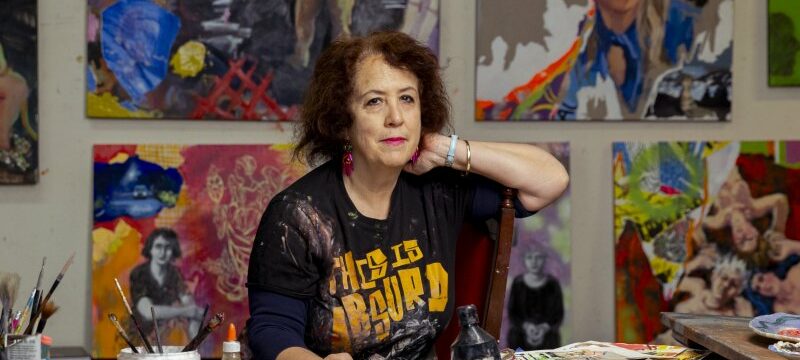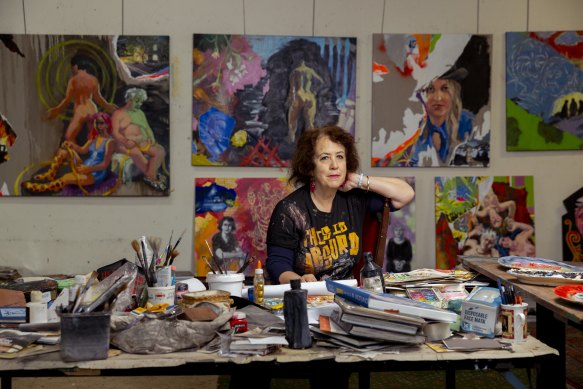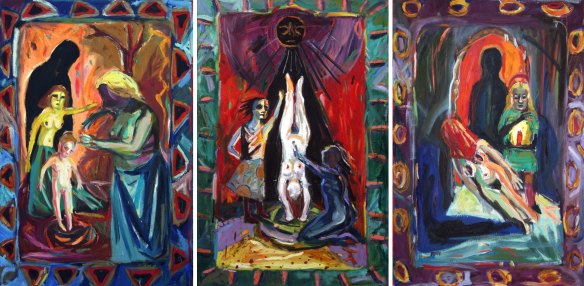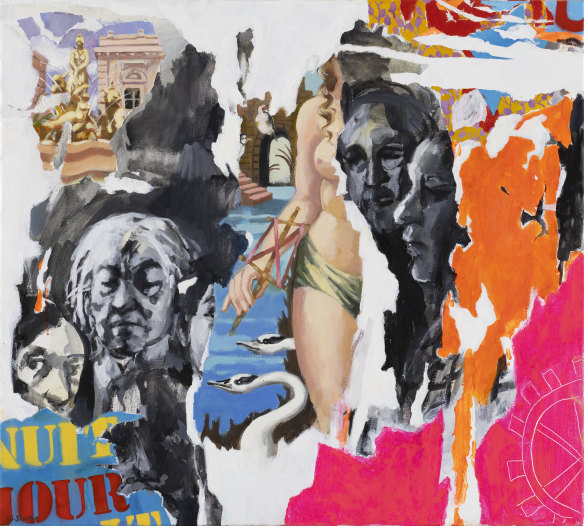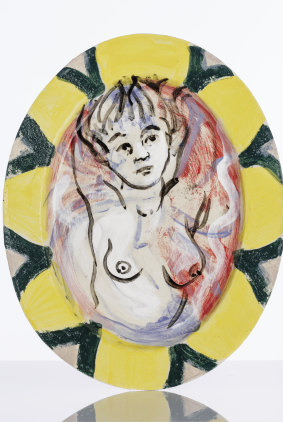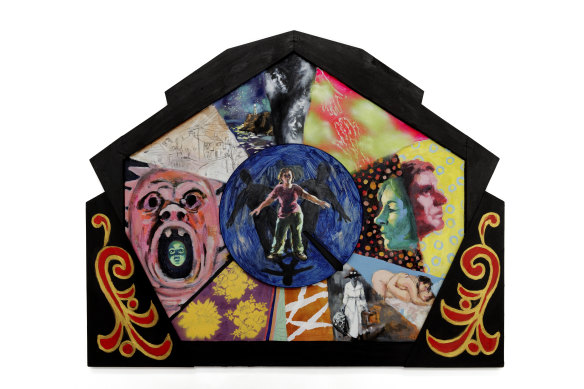Save articles for later
Add articles to your saved list and come back to them any time.
Wendy Sharpe often wonders how her life as an artist might have been different if Albert Tucker had not judged the 1986 Sulman Prize.
No other artist, Sharpe believes, would have chosen her as the winner.
Wendy Sharpe pictured in her studio in Sydney.Credit: Dominic Lorrimer
“Albert Tucker didn’t know who I was. Nobody did because I’d just left art school. But he didn’t care, and my painting resonated with him,” Sharpe says.
Tucker’s paintings were human and expressionistic, and perhaps he sensed a similar sensibility at work in Sharpe’s raw figurative triptych.
At 26, Sharpe could not have foreseen that winning the Sulman with her work Black sun – morning to night would have a “butterfly effect” on her life. (The joint winner of that year’s Sulman was Nigel Thomson.)
Sharpe’s Sulman Prize-winning painting, Black sun – morning to night.Credit: Wendy Sharpe
She would go on to travel the world, create countless exhibitions and work tirelessly for various women’s charitable institutions and refugee services by donating pictures for them to sell and speaking at their events.
This year, she was made a Member of the Order of Australia for significant service to the visual arts and to the community.
Sharpe believes her Sulman win was the result of fate, chance and timing, and these determinative forces have always intrigued her.
“So much is chance,” she says. “Most things in life are about timing; it’s about being in the right place at the right time.”
She describes her family as having included a number of psychics, and she grew up listening to stories about them. This piqued her interest in mysticism and destiny – ideas that lie at the heart of her latest solo exhibition, aptly titled Wheel of Fortune, which opens on August 1.
Many of the paintings depict the three Fates, who in Greek and Roman legend determined the length of a person’s life. They spun the thread of life, measured it out and cut it off.
Sharpe depicts these ladies coolly inhabiting today’s world, wearing tough-girl accessories such as Doc Martens and tats.
Many of the paintings in the exhibition use the technique of trompe l’oeil to evoke the mishmash of torn advertising posters that Sharpe observed recently on the Paris Metro. She is often on the Metro since she owns an apartment in Paris.
With one image appearing to be torn away to reveal another one underneath, these Metro-inspired paintings are about the concept of time, Sharpe says.
The posters remind her of pentimento, an art term that describes when the upper layers of an image become transparent over time and reveal an earlier image.
In the exhibition catalogue, she writes: “Multiple images take us beyond the surface of things, suggesting alternate scenarios, secrets or hidden truth.”
Distant memories (with Il Sodoma’s Fates) by Sharpe.Credit: John Fotiadis
For Wheel of Fortune, Sharpe collaborated with potter Janna Ferris to create First Morning.Credit: John Fotiadis
Distant Memories (with Il Sodoma’s Fates) depicts poster fragments in contemporary fluorescent colours that are ripped away to reveal a section of a painting of the Fates by Italian Renaissance painter Il Sodoma, whose real name was Giovanni Antonio Bazzi.
Sharpe’s paintings reference several other historical artists including Winslow Homer and Goya. But there’s no set narrative to any of the works. She instead offers them as an invitation for viewers to ponder.
“There’s information and ideas there for people to look at and imagine, from their own life, what’s going on,” she says.
Sharpe likes to make something different for every exhibition, so for Wheel of Fortune she has painted on ceramics made by Australian potter Janna Ferris.
The pair’s long-term collaboration began in the 1990s when they met by chance.
“I was looking for a flatmate and I spoke to a friend who said, ‘Oh, my friend Janna is looking for somewhere,’ ” Sharpe says.
“Janna moved in, we became friends, we’ve travelled together and now all these years later, there she is in this [exhibition]. It’s a series of chances.”
The exhibition even includes a kinetic artwork painted on wood, with a spinning central disc and an arrow that can settle on a dozen possible images, from a moody lighthouse to a snarling Renaissance monster to a love-making couple.
Wheel of Fortune by Wendy Sharpe, which features a spinning central disc.Credit: John Fotiadis
Painted on the spinning disc is a woman who stands unsteadily, as if groping in the dark. The work is titled Wheel of Fortune.
A final word about Albert Tucker and the Sulman Prize all those years ago.
Sharpe recalls that she and a bunch of friends were rejected from the Moet and Chandon art scholarship on the same day that artists were able to take their work to the Art Gallery of NSW to enter the Sulman.
The friends collected their rejected works in The Rocks, piled them on the back of a ute, strapped them down with more enthusiasm than care and dashed to the gallery to deliver them to the Sulman Prize.
Miraculously the strap held, and the rest is history.
Of course, the Fates don’t always orchestrate things as we would want.
“I think sometimes these Fates are not looking. They must be watching TV at the same time,” Sharpe says.
Wheel of Fortune is at Sydney’s King Street Gallery on William from August 1 to 26.
Elizabeth Fortescue and Wendy Sharpe have collaborated on a book about the artist, to be published by Wakefield Press later this year.
The Booklist is a weekly newsletter for book lovers from books editor Jason Steger. Get it delivered every Friday.
Most Viewed in Culture
From our partners
Source: Read Full Article
